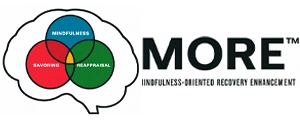MORE CLAIMS
and citations
Stats & Benefits
of MORE
A brighter life with our simple programme
Are you stuck in a job you don’t enjoy? Not sure which career direction to take? If you want to have a job you are passionate about, the good news is you can! Find your dream job using our proven, comprehensive 6 step program.
- MORE cuts opioid misuse by 45%, tripling the effect of standard group therapy, with effects sustained for 9 months and longer (11 months after the start of the trial)1
- Through MORE, on average patients reduced their opioid dose by 31%,2 and 36% of patients reduced their dose by 50% or more1
- MORE reduces drug craving by 50%.3 In people addicted to cigarettes, MORE reduces craving by 30%.4 In people with alcohol use disorder, MORE reduces craving by 27%.5
- MORE reduces drug relapse by 42%.6
- MORE reduces addiction treatment dropout by 59%.6
- MORE reduces days of drug use by 42%.6
- 39% of patients treated with MORE were able to quit smoking, increasing smoking abstinence by 55% more than CBT.7
- In people with PTSD, MORE leads to clinically significant reductions in PTSD symptoms in 59% of patients.8
- In people with major depression, MORE reduces depression symptoms by 38% more than standard group therapy. 1 Also in this study,
- 70% of patients met criteria for major depression at the beginning of the trial. 11 months later patients depression symptom levels were below the threshold for major depression.1
- MORE increases positive emotions by 2.75 times more than standard group therapy9
- A singe, 15-minute MORE mindfulness practice reduced acute pain by approximately 30%, the same amount of pain relief that would be produced by 5 mg of oxycodone10
- Before hip and knee replacement surgery, a single 15-minute pre-operative MORE mindfulness practice reduced pain by 49%.11 1 month after joint replacement surgery, a single, 15-minute pre-operative MORE mindfulness practice reduced post-operative pain by
- 45% more than brief CBT.11 15-minutes of pre-operative MORE mindfulness practice reduced the relative risk of post-treatment opioid use by 95% compared to CBT.11 (2% of patients treated with brief mindfulness were taking opioids 1 month after surgery compared to 40% in brief CBT)
- In patients undergoing joint replacement surgery, a single 15-minute MORE mindfulness practice improved physical function at 6-weeks post-surgery to a level of function typically seen 3-months after surgery.12
- A single 15-minute MORE mindfulness practice reduced anxiety by 43% and desire for pain medicatiton by 35%12
- MORE reduces chronic pain symptoms by 25% with effects sustained 9 months and longer (11 months after the start of the trial).1 1 in 2 patients treated with MORE achieved clinically significant reductions in pain.1
- MORE is twice as effective as CBT at improving negative emotion regulation.7
- MORE reduced video game addiction by 67%, and was 2.3 times more effective than standard group therapy at reducing video game addiction. MORE reduced video game craving by 41%.13
- MORE improves cognitive functions including attentional control14,15 and inhibitory control16
- MORE helps the brain reward system recover from the effects of addiction. Following treatment with MORE, the brains of patients with opioid use disorder show similar levels of reward response during savoring to the brains of people without opioid use disorder.17
- MORE reduces anhedonia by increasing brain reward responses.18
- MORE significantly decreases craving responses in the brain.19
- MORE reduces drug use and misuse by increasing brain activity linked with self-control.20,21
- For every $1 spent on MORE, there are $798 in cost savings. The lifetime economic impact from quality of life, decreased mortality & morbidity, and improved productivity are estimated to be $320,216 per person.4
STEP 1Goal setting
Establish your short-term and long-term career goals and a forward-looking career road map.
STEP 2Explore
Help you understand yourself, what is important to you and monitor how changes in your interests, skills relate to your career.
STEP 3Discover
Learn about different careers, understand the components and requirements to make a final decision.
STEP 4Action Plan
Create a tactical plan to get you from where you are today to where you want to be. We help fine-tune your plans.
MORE References
- Garland EL, Hanley AW, Nakamura Y, et al. Mindfulness-Oriented Recovery Enhancement vs supportive group therapy for co-occurring opioid misuse and chronic pain in primary care: A randomized clinical trial. JAMA internal medicine. 2022;182(4):407-417.
- Garland EL, Hudak J, Hanley AW, Nakamura Y. Mindfulness-oriented recovery enhancement reduces opioid dose in primary care by strengthening autonomic regulation during meditation. American Psychologist. 2020;75(6):840.
- Cooperman NA, Hanley AW, Kline A, Garland EL. A pilot randomized clinical trial of mindfulness-oriented recovery enhancement as an adjunct to methadone treatment for people with opioid use disorder and chronic pain: Impact on illicit drug use, health, and well-being. Journal of Substance Abuse Treatment. Published online 2021:108468.
- Garland E. Mindfulness-Oriented Recovery Enhancement: Evidence-Based Strategies to Change the Brain & Heal Addiction Through Neuroplasticity. In: ; 2025.
- Guierri L, Wardle M, Garland EL. Mindfulness-Oriented Recovery Enhancement Reduces Illicit Substance Craving Among People with Alcohol Use Disorder and Polysubstance Use. Substance Use & Misuse. 2025;in press.
- Cooperman NA, Lu SE, Hanley AW, et al. Telehealth mindfulness-oriented recovery enhancement vs usual care in individuals with opioid use disorder and pain: a randomized clinical trial. JAMA psychiatry. 2024;81(4):338-346.
- Garland EL. Mindfulness-Oriented Recovery Enhancement: Outcomes and Mechanisms of an Evidence-Based Therapy for Addiction, Emotion Dysregulation, and Chronic Pain. In: ; 2025.
- Parisi A, Hudak J, Froeliger B, Garland EL. Mindfulness-Oriented Recovery Enhancement reduces post-traumatic stress via reappraisal among patients with chronic pain and co-occurring opioid misuse. Nature Mental Health. 2023;1(7):489-500.
- Garland EL, Bryan CJ, Finan PH, et al. Pain, hedonic regulation, and opioid misuse: Modulation of momentary experience by Mindfulness-Oriented Recovery Enhancement in opioid-treated chronic pain patients. Drug and alcohol dependence. 2017;173:S65-S72.
- Garland EL, Baker AK, Larsen P, et al. Randomized Controlled Trial of Brief Mindfulness Training and Hypnotic Suggestion for Acute Pain Relief in the Hospital Setting. Journal of General Internal Medicine. 2017;32(10):1106-1113. doi:10.1007/s11606-017-4116-9
- Hanley AW, Gililland J, Garland EL. To be mindful of the breath or pain: Comparing two brief preoperative mindfulness techniques for total joint arthroplasty patients. Journal of consulting and clinical psychology. 2021;89(7):590.
- Hanley AW, Gililland J, Erickson J, et al. Brief preoperative mind–body therapies for total joint arthroplasty patients: a randomized controlled trial. Pain. 2021;162(6):1749-1757.
- Li W, Garland EL, McGovern P, O’Brien JE, Tronnier C, Howard MO. Mindfulness-Oriented Recovery Enhancement for Internet Gaming Disorder in U.S. Adults: A Stage 1 Randomized Controlled Trial. Psychol Addict Behav. 2017;31(4):393-402. doi:10.1037/adb0000269
- Garland EL, Baker AK, Howard MO. Mindfulness-oriented recovery enhancement reduces opioid attentional bias among prescription opioid-treated chronic pain patients. Journal of the Society for Social Work and Research. 2017;8(4):493-509.
- Garland EL, Howard MO. Mindfulness-oriented recovery enhancement reduces pain attentional bias in chronic pain patients. Psychotherapy and psychosomatics. 2013;82(5):311-318.
- Garland EL, Bryan MA, Priddy SE, Riquino MR, Froeliger B, Howard MO. Effects of mindfulness-oriented recovery enhancement versus social support on negative affective interference during inhibitory control among opioid-treated chronic pain patients: A pilot mechanistic study. Annals of Behavioral Medicine. 2019;53(10):865-876.
- Garland EL, Hudak J, Hanley AW, Bernat E, Froeliger B. Positive Emotion Dysregulation in Opioid Use Disorder and Normalization by Mindfulness-Oriented Recovery Enhancement: A Secondary Analysis of a Randomized Clinical Trial. JAMA Psychiatry. 2025;82(7):654-662. doi:10.1001/jamapsychiatry.2025.0569
- Garland EL, Fix ST, Hudak JP, et al. Mindfulness-Oriented Recovery Enhancement remediates anhedonia in chronic opioid use by enhancing neurophysiological responses during savoring of natural rewards. Psychological Medicine. 2023;53(5):2085-2094. doi:10.1017/S0033291721003834
- Garland EL, Atchley RM, Hanley AW, Zubieta JK, Froeliger B. Mindfulness-Oriented Recovery Enhancement remediates hedonic dysregulation in opioid users: Neural and affective evidence of target engagement. Science Advances. 2019;5(10):eaax1569.
- Garland EL, Hanley AW, Hudak J, Nakamura Y, Froeliger B. Mindfulness-induced endogenous theta stimulation occasions self-transcendence and inhibits addictive behavior. Science Advances. 2022;8(41):eabo4455. doi:10.1126/sciadv.abo4455
- Hudak J, Hanley AW, Marchand WR, Nakamura Y, Yabko B, Garland EL. Endogenous theta stimulation during meditation predicts reduced opioid dosing following treatment with Mindfulness-Oriented Recovery Enhancement. Neuropsychopharmacology. 2021;46(4):836-843.
Transform Recovery. Empower Healing.
Join the movement to expand access to evidence-based, neuroscience-informed care. Our Mindfulness-Oriented Recovery Enhancement (MORE) training equips healthcare professionals with the tools to treat addiction, pain, and emotional distress with compassion and clinical precision.



